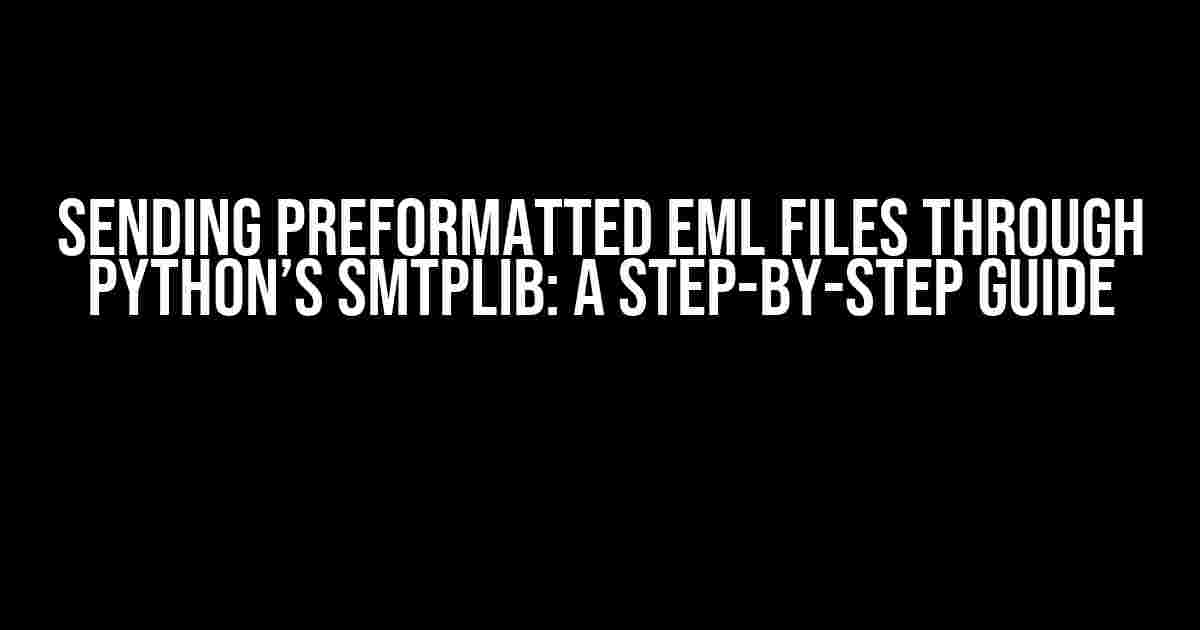Are you tired of generating emails from scratch using Python’s SMTPlib? Do you have preformatted EML files that you want to send to recipients with minimal hassle? Look no further! In this comprehensive guide, we’ll show you how to send preformatted EML files through Python’s SMTPLIB when the recipient is already included in the EML file content.
- What is an EML File?
- Why Use Preformatted EML Files?
- Prerequisites
- Step 1: Importing Necessary Modules
- Step 2: Parsing the EML File
- Step 3: Extracting the Recipient’s Email Address
- Step 4: Creating a SMTP Connection
- Step 5: Sending the EML File
- Step 6: Closing the SMTP Connection
- Putting it all Together
- Common Issues and Troubleshooting
- Conclusion
What is an EML File?
An EML file is an email message saved in a file format that is compatible with most email clients, including Microsoft Outlook and Mozilla Thunderbird. EML files contain the email’s content, including the subject, body, and attachments. They can be generated manually or programmatically using libraries like Python’s email module.
Why Use Preformatted EML Files?
Using preformatted EML files can save you time and effort when sending emails programmatically. Here are some benefits:
- Consistency**: Preformatted EML files ensure consistency in email formatting and structure, making it easier to maintain a professional brand image.
- Efficiency**: You can generate EML files in advance and send them as needed, reducing the time spent on email composition.
- Customization**: Preformatted EML files can be tailored to specific use cases, allowing for greater flexibility in email content and design.
Prerequisites
Before we dive into the tutorial, make sure you have the following:
- Python 3.x installed on your system
- The smtplib and email modules installed (comes bundled with Python)
- A preformatted EML file with the recipient’s email address included in the file content
- A working email account with SMTP access
Step 1: Importing Necessary Modules
Begin by importing the necessary modules:
import smtplib
from email.parser import Parser
from email.mime.multipart import MIMEMultipart
from email.mime.base import MIMEBase
from email import encoders
from email.utils import formataddrStep 2: Parsing the EML File
Load the preformatted EML file into a Python script using the Parser module:
with open('email.eml', 'r') as f:
msg = Parser().parse(f) # Parse the EML fileIn this example, we assume the EML file is named “email.eml” and is located in the same directory as the Python script.
Step 3: Extracting the Recipient’s Email Address
Extract the recipient’s email address from the EML file content:
recipient_email = msg['To'] # Extract the recipient's email addressIn this example, we assume the recipient’s email address is stored in the “To” field of the EML file.
Step 4: Creating a SMTP Connection
Establish a connection to your email provider’s SMTP server:
smtp_server = 'smtp.example.com' # Replace with your SMTP server
smtp_port = 587 # Replace with your SMTP port
smtp_user = '[email protected]' # Replace with your email address
smtp_pass = 'your_password' # Replace with your password
server = smtplib.SMTP(smtp_server, smtp_port)
server.starttls()
server.login(smtp_user, smtp_pass)Make sure to replace the placeholders with your actual email provider’s settings.
Step 5: Sending the EML File
Send the preformatted EML file using the SMTP connection:
msg_str = msg.as_string() # Convert the parsed EML file to a string
server.sendmail(smtp_user, recipient_email, msg_str) # Send the EML fileIn this example, we use the sendmail method to send the EML file to the recipient’s email address.
Step 6: Closing the SMTP Connection
Close the SMTP connection to free up system resources:
server.quit()Putting it all Together
Here’s the complete code snippet:
import smtplib
from email.parser import Parser
from email.mime.multipart import MIMEMultipart
from email.mime.base import MIMEBase
from email import encoders
from email.utils import formataddr
with open('email.eml', 'r') as f:
msg = Parser().parse(f) # Parse the EML file
recipient_email = msg['To'] # Extract the recipient's email address
smtp_server = 'smtp.example.com' # Replace with your SMTP server
smtp_port = 587 # Replace with your SMTP port
smtp_user = '[email protected]' # Replace with your email address
smtp_pass = 'your_password' # Replace with your password
server = smtplib.SMTP(smtp_server, smtp_port)
server.starttls()
server.login(smtp_user, smtp_pass)
msg_str = msg.as_string() # Convert the parsed EML file to a string
server.sendmail(smtp_user, recipient_email, msg_str) # Send the EML file
server.quit()Common Issues and Troubleshooting
Here are some common issues you might encounter and their solutions:
| Issue | Solution |
|---|---|
| SMTP connection timeout | Check your SMTP server settings and ensure the server is responding. |
| Authentication failure | Verify your email address and password, and ensure they are correct. |
| EML file not parsing correctly | Check the EML file format and ensure it is valid and well-formed. |
| Recipient’s email address not extracted correctly | Verify the recipient’s email address is stored in the correct field (e.g., “To”) in the EML file. |
Conclusion
In this comprehensive guide, we’ve shown you how to send preformatted EML files through Python’s SMTPLIB when the recipient is already included in the EML file content. By following these steps, you can streamline your email sending process and reduce the time spent on email composition. Remember to tailor your EML files to specific use cases and customize them to fit your needs.
Happy coding!
Frequently Asked Question
Got questions about sending preformatted EML files through Python’s SMTPLIB when the recipient is already in the EML file content? We’ve got you covered!
How do I send a preformatted EML file using Python’s SMTPLIB?
You can send a preformatted EML file using Python’s SMTPLIB by using the `send_message()` function and passing the EML file as a string. First, open the EML file and read its content, then pass it to the `send_message()` function along with the SMTP server details and the recipient’s email address.
Do I need to specify the recipient’s email address when sending an EML file?
No, you don’t need to specify the recipient’s email address when sending an EML file using Python’s SMTPLIB if the recipient is already specified in the EML file content. The EML file contains the recipient’s email address, so you can simply pass the EML file content to the `send_message()` function and the email will be sent to the specified recipient.
How do I read the EML file content using Python?
You can read the EML file content using Python by opening the file in read mode (`’r’`) and using the `read()` function to read its content. For example, `with open(‘example.eml’, ‘r’) as f: eml_content = f.read()`. This will read the entire EML file content into a string, which can then be passed to the `send_message()` function.
What is the advantage of using EML files instead of building the email message from scratch?
Using EML files provides a convenient way to send preformatted emails with complex content, such as HTML emails with images and attachments, without having to build the email message from scratch using Python. This can save time and effort, and ensure that the email is sent in the desired format.
Is it possible to modify the EML file content before sending it using Python’s SMTPLIB?
Yes, it is possible to modify the EML file content before sending it using Python’s SMTPLIB. You can use Python’s string manipulation functions to modify the EML file content, such as replacing placeholders with actual values, before passing it to the `send_message()` function. However, be careful not to modify the email headers or structure, as this can cause issues with email delivery.


